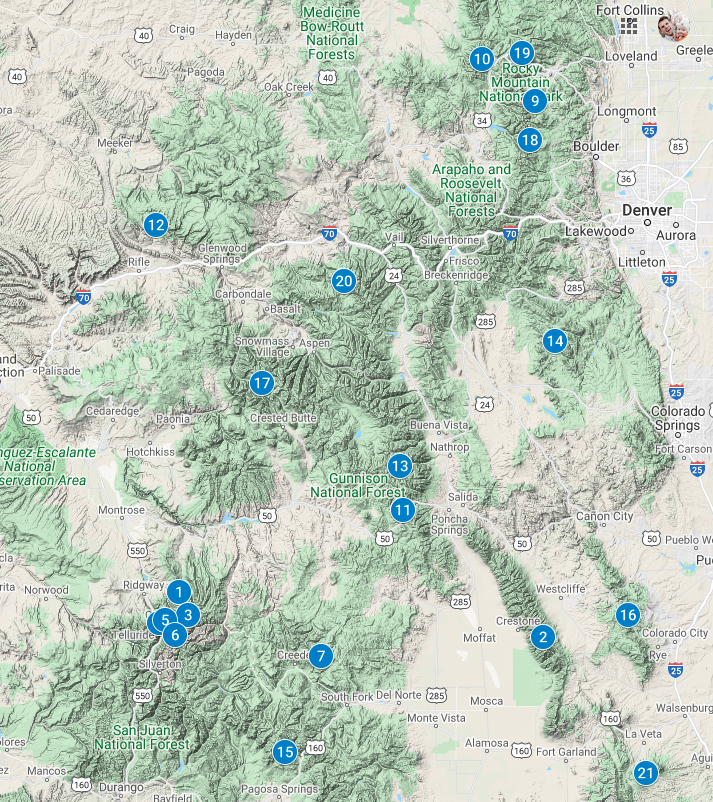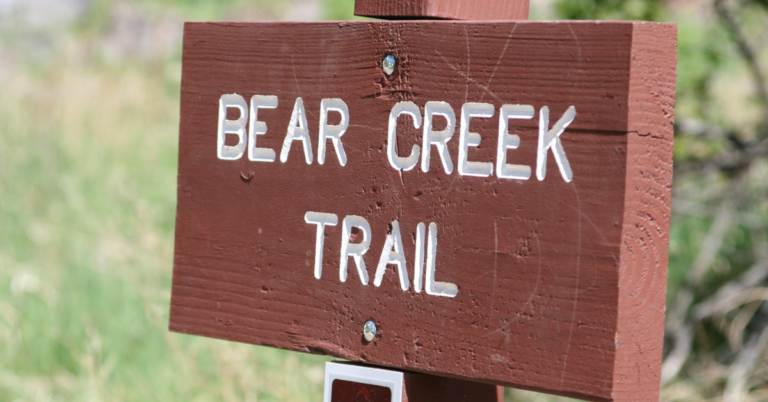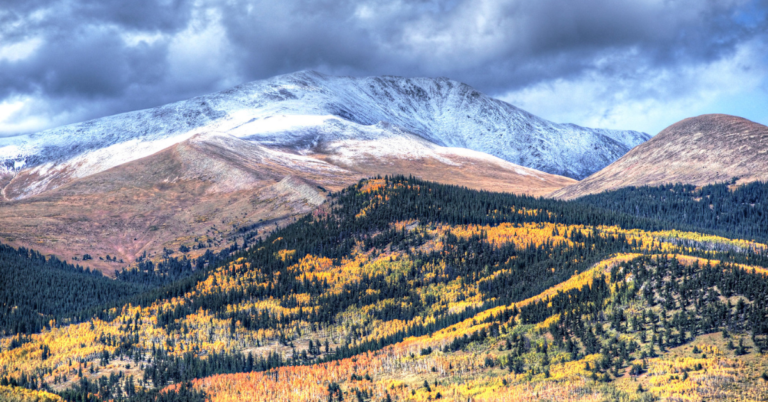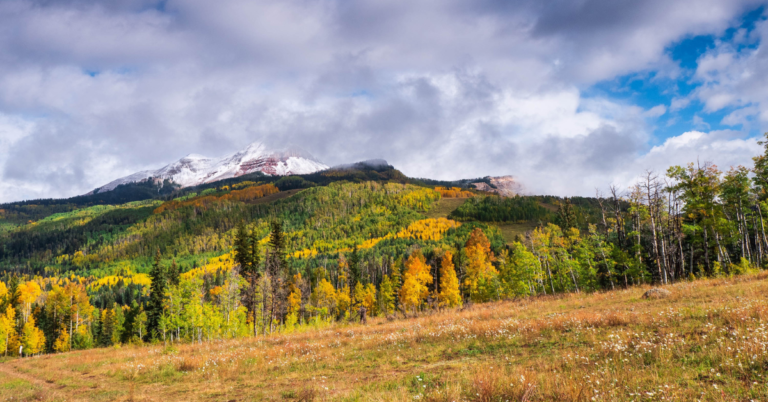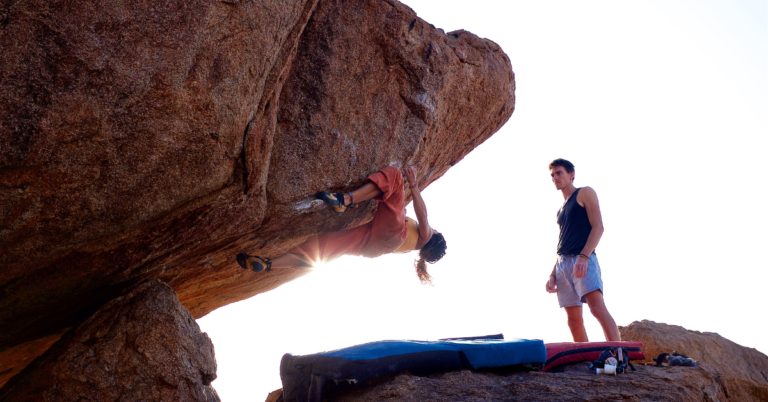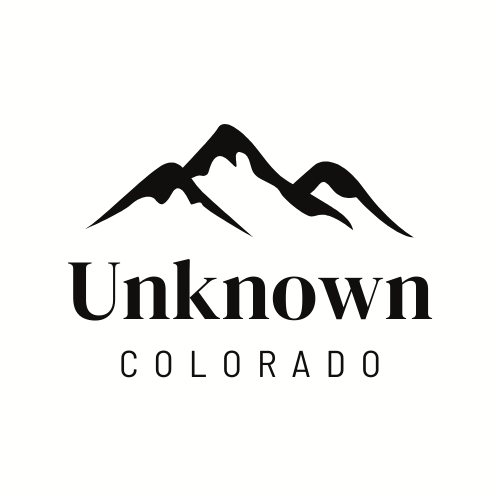Colorado contains a trove of outdoor treasures, but I’d be lying if I said they were secluded. While Rocky Mountain National Park, Mount Elbert, and the Maroon Bells are not-to-miss destinations, you won’t find much peace and quiet.
Get in line, make a reservation, and get ready to sit in traffic because you’ll be joining the masses at these go-to Colorado spots.
Fortunately, the best-hidden gems in Colorado lie off the beaten path. And they’re arguably just as good (if not better) than the most-visited outdoor favorites.
Pack a lunch, bring your satellite phone, and get ready for an adventure—because there’s a good chance you won’t see many other souls at these outdoor gems.
21 Best Hidden Gems in Colorado
Use the map above to find the best-hidden gems in Colorado.
Below, I’ll cover what makes these must-see places and what you should expect when you visit. The following aren’t listed in any particular lineup—just the order in which they popped into my reminiscing mind.
1. Owl Creek Pass
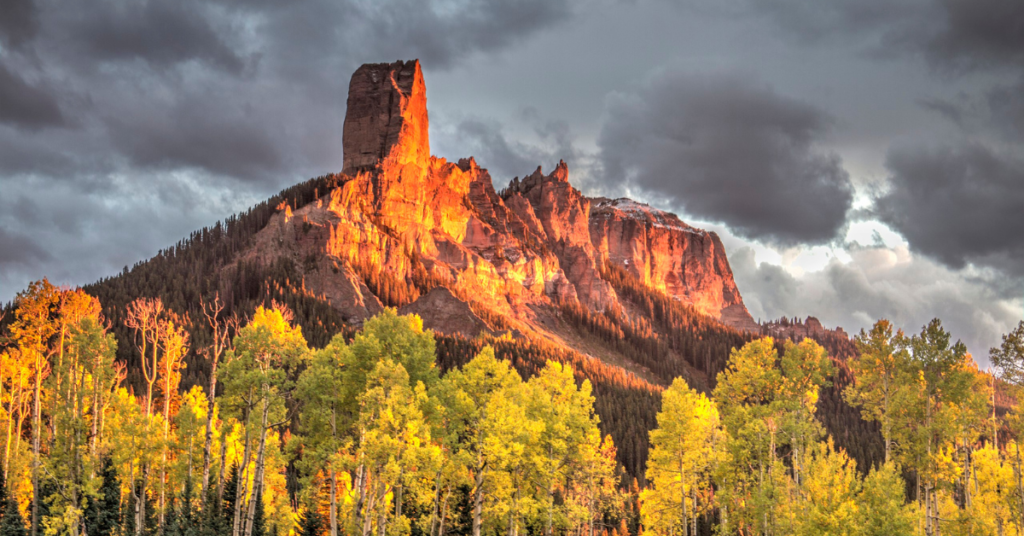
Make sure you clear your phone’s memory because you’re about to see one heck of a landscape. The Owl Creek Pass off-highway vehicle (OHV) road takes you up and through the towering Cimarron Ridge.
The road tops out on Owl Creek Pass at 10,114 feet before diving down to Silver Jack Reservoir below. You’ll see the best views of Chimney Rock and Courthouse Mountain from the nearby town of Ridgway, but you’ll catch a glimpse of this stunning range here and there throughout your winding trip up to the pass.
Don’t be deterred by the OHV indication. The road is well maintained and doesn’t have any serious difficulties. 2WD passenger vehicles shouldn’t have any problem, as long as you go on a clear weather day and drive with care.
My 1st time up Owl Creek Pass, I didn’t see a single other vehicle. My 2nd time up (in the very early morning), I went and climbed Courthouse Mountain—again, never saw another vehicle until later on my descent back into Ridgway.
2. South Colony Lakes
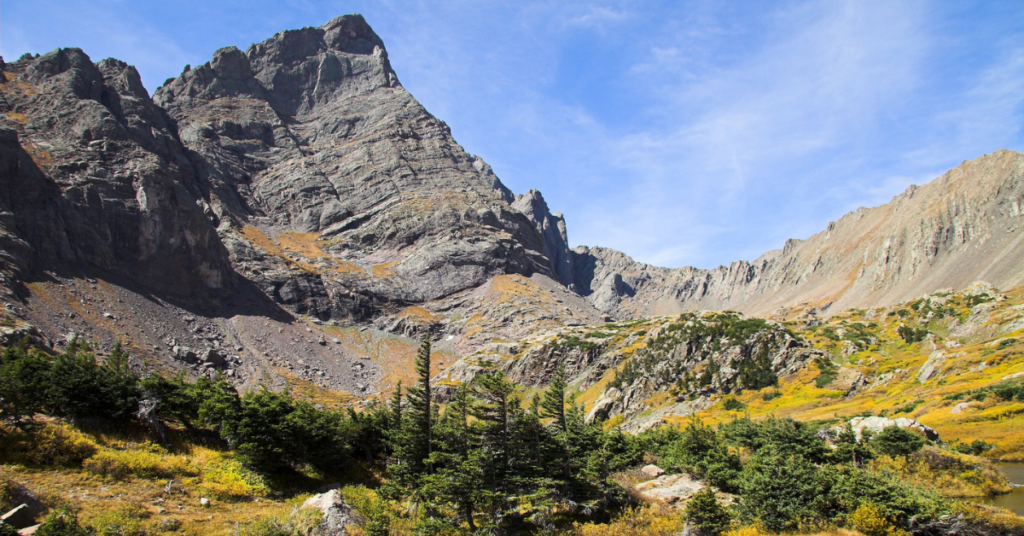
South Colony Lakes is one of Colorado’s best-hidden gems. 14’er baggers are familiar with the area, as well as anglers who enjoy catching trout at high-altitude alpine lakes. Everyone else: practically clueless.
It’s about 3.6 miles one-way with close to 2,000 feet of elevation to reach the Lower South Colony Lake. From the base, you’ll look straight up Crestone Needle (14’er) and try to catch your breath. This mountain is a beaut. Look southwest, and you can see the faint trail (and probably a hiker or 2) making their way up to Broken Hand Pass, the primary route for reaching Crestone Needle and Crestone Peak. Look to the north, and you’ll see the ridgeline leading to Humboldt Peak’s summit (another 14’er).
Enjoy a weekend of backpacking, go fishing, and tackle some of the Sangre De Cristo Range’s most jaw-dropping mountains. On a weekend in July or August, you’ll likely encounter quite a few people. However, take a trip on a weekday, and you might just have these mountains to yourself.
The road up to the South Colony Lakes Trailhead is a bit dicey at times, but it’s nothing compared to the more challenging off-road conditions you’ll find in the San Juan Mountains. Drive a 4WD vehicle and take your time—you’ll be fine.
If you don’t want to brave the rocks and road, you can park at South Colony Parking Area (2WD). However, be prepared for a long hike up a fire road—one in which you might be kicking yourself for not trying to go a bit further.
3. Wetterhorn Peak

Most of Colorado’s 14’ers don’t promise much solitude, but there’s a good chance you’ll have the peak to yourself (at least for a little bit) when you summit Wetterhorn Peak. This jewel of a mountain lies between Ouray and Lake City, those it’s better accessed with a short drive along the Alpine Loop from Lake City.
Warning: this hike isn’t for those who are afraid of heights.
You’ll encounter a few short (though exposed) class 3 scrambles on the standard route. They’re quick and fun (if you’re into that kind of thing) but not for the faint of heart. Expect around 6.5 miles round-trip (RT) and close to 3,000 feet of elevation gain.
From the top of Wetterhorn Peak, you can see practically the entire San Juan Wilderness. Look east, and you’ll see the other local 14’er, Uncompahgre Peak. Look west, and you’ll likely see Mount Sneffels.
Most hikers attempt Wetterhorn Peak from the Matterhorn Creek Trailhead, but the upper 4WD lot can be a beast to reach. 4WD jeeps and side-by-sides shouldn’t have too many problems, but trucks will find themselves scratching on the overhanging branches. This happened to be my first real offroad adventure, and while it’s relatively short, I didn’t love the road in my F-150 at 3am.
If you have a 2WD vehicle, just park at the base of the road and hike your way up—it might add a bit of elevation to your trip, but you’ll likely be going nearly as fast (if not faster) than most of the vehicles.
4. Perimeter Trail
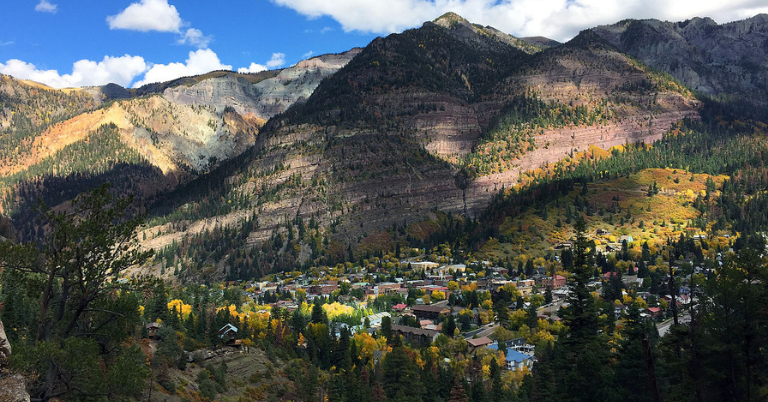
Welcome to Ouray, the Switzerland of America. If you want to get the most bang for your hiking buck in town, take a stroll along the Perimeter Trail. This 7-mile RT loop boasts varied terrain, 5 bridges, 1 cave, and 4 waterfalls.
I’d rate it as family-friendly since I live here, and my children (all under 4) can handle most of the terrain independently. Everywhere you look, regardless of where you are along the trail, you’ll find breathtaking views whether you’re looking west at the Amphitheater, south towards Abrams Mountain, or east at Old Twin Peaks, Sister Peak, and Whitehouse Mountain.
The Perimeter Trail is fantastic during the winter months. Many locals get out and hike, making for a relatively broken trail, regardless of the recent snowstorms. You’re bound to find solitude, silence, and beautiful views every step of the way.
If you don’t have the stamina (or desire) to walk the full loop, you can hop on or off the Perimeter Trail practically anywhere along the loop—you’re always at least 1/2 mile and 500 feet of elevation change away from the city’s limits.
5. Bridge of Heaven
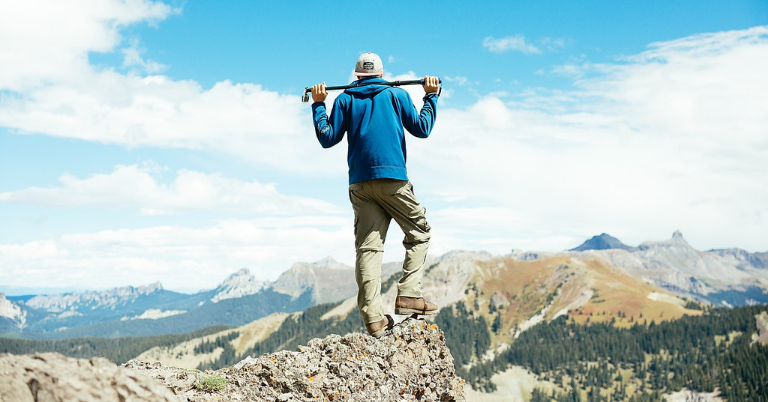
While you’re still in Ouray, get out and above town on the Horsethief Trail. The old trail leaves straight from town, but it’s a beast of a climb. Instead, drive north out of town and hop off on CO Road 14. It’ll take you to the new Horsethief Trail, where you’ll enjoy a delightful climb through aspen forests as you make your way to the top of the mountains surrounding Ouray.
The trail is about 8.1 miles out-and-back with close to 3,000 feet of elevation gain, but the views from the top are more than worth it. While the trail keeps going and going, your journey stops at the Bridge of Heaven—a beautiful overlook with panoramic views of the entire San Juan Mountains. Look around at all the snow-capped peaks, or take a peek down into the town of Ouray.
This hike is on the more strenuous side, but you’re treated with shade and views for almost the entire duration. Time flies (almost too quickly) as you ascend to the celestial heights.
6. Alpine Loop
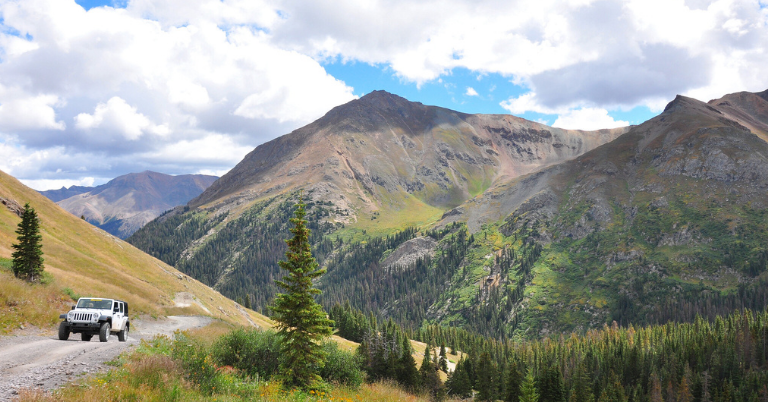
Before you leave the San Juan Mountains, no trip is complete without a journey along the Alpine Loop. Whether you want to explore it by jeep, four-wheeler, or mountain bike, there’s no wrong way to travel these alpine dirt roads.
The 65-mile loop takes you through rugged, remote mountainous territory, connecting the towns of Ouray, Silverton, and Lake City. You’ll pass waterfalls, connecting trailheads to towering 14’ers, wildflowers, and wildlife. While you won’t find much solitude along the road during the summer months, you can find hidden gems along the web of trails and among the peaks.
7. Wheeler Geologic Area
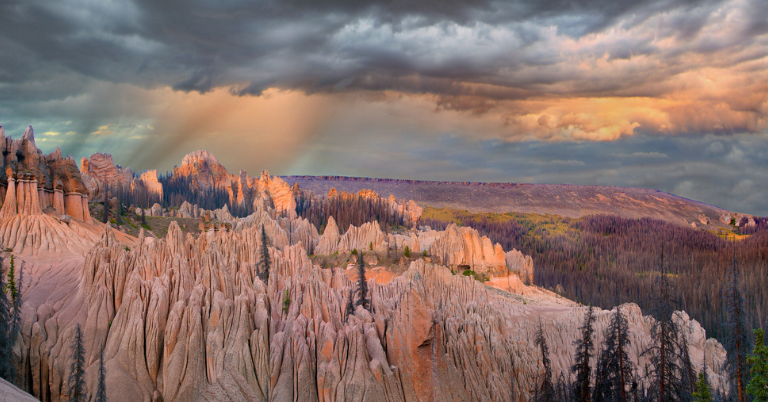
Wheeler Geologic Area features some of Colorado’s most unique rock formations, but most visitors (and even locals) don’t even know it exists. This once was one of Colorado’s busiest attractions, but it’s since lost popularity due to its remote middle-of-nowhereness—but that’s what’s so appealing about it now.
Words and pictures don’t do justice for the Wheeler Geologic Area. It’s a place you’ll visit and wonder, “Why don’t more people talk about this?” In 1943, there were fewer than 50 visitors the entire year—which makes sense given how long, rough, and bumpy the road is to get there.
Enjoy the peculiar formations, take a long hike, and spend an entire weekend immersed in the rugged wilderness. Don’t rush it—you earned this experience.
8. Paint Mines Interpretive Park
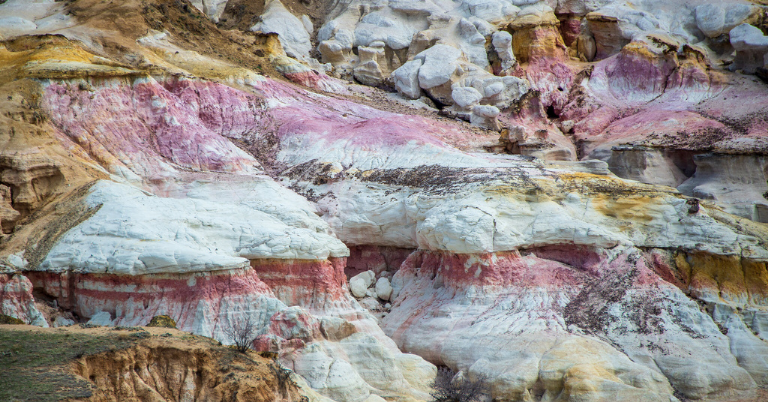
Just 30 miles away from Colorado Springs lies a unique open space with brightly colored clay bands that resemble the remnants of a wild galactic party. Paint Mines Interpretive Park features spires, hoodoos, and other natural wonders.
Due to its proximity to Colorado Springs and Denver, it’s not quiet on the weekends, but you’re bound to have stretches of the 4-mile trails to yourself on a weekday. Yet, it feels like an other-worldly escape when you’re meandering through the strange colored rock formations—much like a trip to Meow Wolf.
9. Mount Meeker
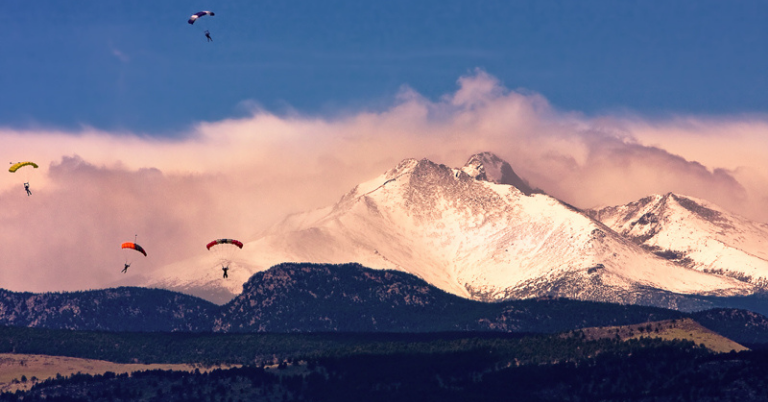
Meeker might attract the eyeballs of millions of residents along the Front Range, but it’s not an often visited peak—especially due to its close proximity to its taller sister: Longs Peak. However, Mount Meeker is a centennial peak (one of Colorado’s 100 tallest mountains), and it’ll take you on a secluded adventure.
Most climbers take the standard route up the Loft, making for a pretty straightforward climb up Meeker. You’ll still get to experience some fear-inducing exposure and scrambles, but it’s nothing most peak baggers will blink twice at. The real adventure lies through the Iron Gates Route.
The Iron Gates Route takes you southwest from Chasm Lake and onto Meeker’s East ridge. It’s full of class 3 scrambles, and it even has a short knife-edge that’ll have aspiring Capitol Peak climbers getting their practice in. If you’re afraid of heights or lack climbing experience, stick with the Loft route.
Whether you’re hiking on a Tuesday or a Saturday, there’s a good chance you’ll have this lovely summit to yourself. Take in the views of the Front Range, spot the hordes of folks making their way up Longs Peak, and snap a quick picture of a furry marmot.
10. Never Summer Mountains
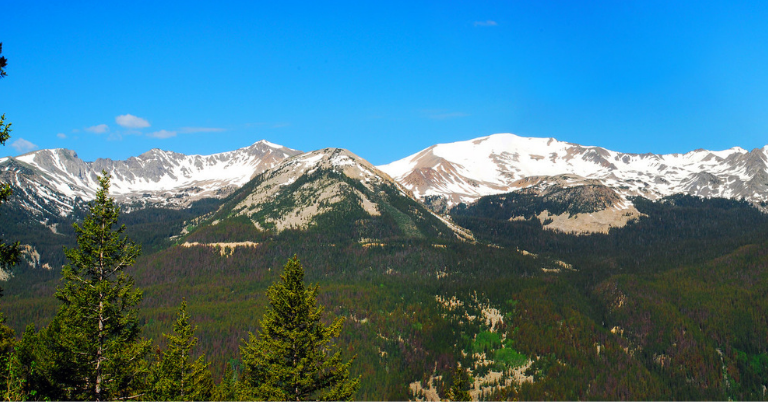
While the Never Summer Mountains are technically within Rocky Mountain National Park, you’ll feel far away from the crowds on these 17 named peaks. Even in July, you’ll find most of the high peaks still carry a bit of snow, aptly earning them the name “Never Summer” mountains.
Most of these peaks are quite rugged and remote to climb, but you don’t need to bag any summits to enjoy this secluded wilderness. Stroll along the endless trails, find a lake or 2, and try to catch sight of a moose. You’ll even find some of the state’s oldest spruce and fir trees, with some being an estimated 600 years old.
11. Monarch Mountain
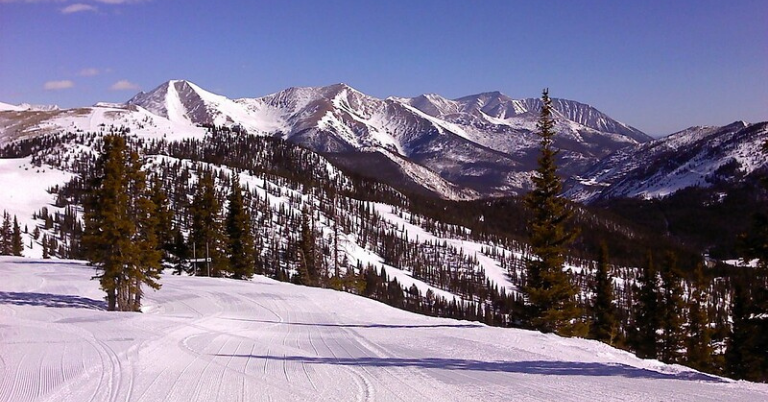
Skiing and hidden gems don’t usually go hand in hand, but Monarch Mountain makes an exception. This relatively small ski resort has 54 trails, 2 terrain parks, and terrain for every level of skier.
While its location is along a popular stretch between the Western Slopes and the Front Range, few stop to give Monarch Mountain a try. Instead, they opt for nearby Crested Butte, but they’re missing out.
Monarch Mountain is all about “Real People, Real Snow.” They boast 100% natural snow, and with no crowds, you’re bound to find fresh powder without trying too hard.
12. Rifle Mountain Park
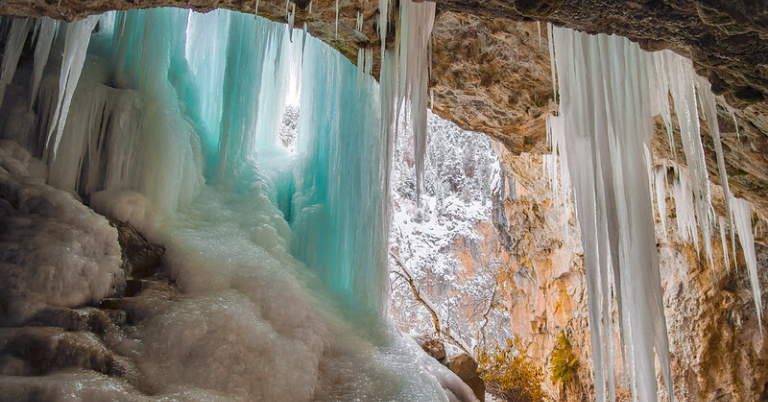
Most tourists take a trip to the Hanging Lakes or Rifle Falls State Park (and for good reason), but the majority don’t make it to the equally impressive nearby Rifle Mountain Park. This rock climbing oasis features vertical walls with over 250 bolted routes.
The area is perfect for climbing, camping, hiking, driving, or just a picnic. In the winter, frozen waterfalls make for ideal ice climbing conditions for the hearty cold-loving folk. Expect to see amazing rock walls and discover isolated caves along this stretch of wilderness.
Whether you’re an experienced climber or just wanted to get started, Rifle Mountain Park is one of the best-hidden gems in Colorado.
13. Saint Elmo Ghost Town
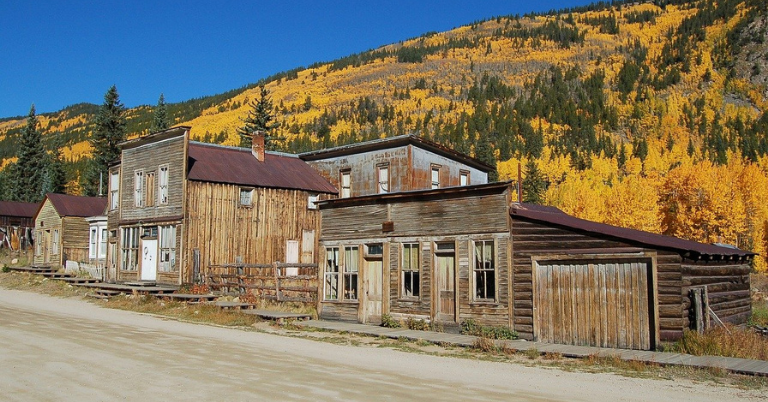
Journey back in time to the year 1880, where nearly 2,000 folks gathered to mine for gold and silver near Buena Vista. This is one of the best-preserved ghost towns in the West, and it’s just a short drive to access with 2WD vehicles.
You can find plenty of local hikes nearby, and the St. Elmo General Store is open for snacks, drinks, and souvenirs. Oh, and you also get to pass the beautiful white Chalk Cliffs on the southside of resident 14’er, Mount Princeton, on your drive up.
14. Bison Peak
Bison Peak is a hidden gem in the Lost Creek Wilderness. It’s the tallest summit in the Tarryall Mountain range, and it’s the perfect hike in the early summer (late spring) when the alpine terrain is still buried in snow.
You’ll find rock towers, strange formations, and fun little scrambles in this foreign-looking landscape. It looks less like a Colorado high point and more like something from a Sci-Fi movie, but it’s the kind of mountain you’ll want to revisit again and again.
The hike will take you around 11 miles round trip with close to 4,000 feet of elevation gain, so it’s no walk in the park, but the miles go by quickly once you start to meander among the haphazard rock towers.
15. Weminuche Wilderness
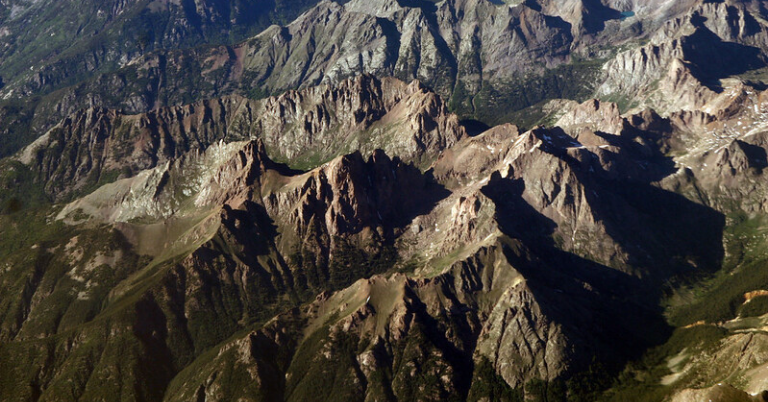
The San Juan Mountains are remote enough, but the Weminuche Wilderness is a diamond hiding among gems. This wilderness is the largest in Colorado (at 499,771 acres), and it offers plenty of solitude for hikers, climbers, and backcountry campers.
You’ll find Eolus, Sunlight, and Windom peaks (all 14’ers) in this wilderness, along with many other breathtaking 13,000-foot mountains. The average elevation in the wilderness is 10,000 feet above sea level, so make sure you’re acclimated before you stroll off into this high-altitude ecosystem.
You can also find over 50 miles of the Continental Divide running through this wilderness, diverting the nation’s headwaters to either the Pacific or Atlantic oceans—which is really fascinating when you stop and think about it.
16. Bishop Castle
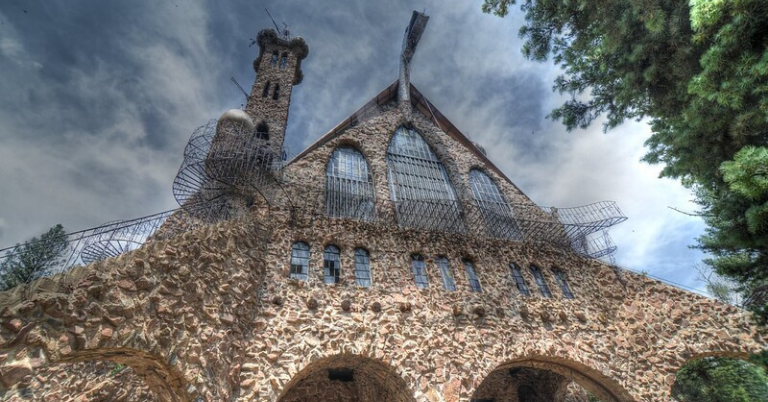
Bishop Castle has been dubbed the one-man project, as Jim Bishop has worked for decades to build a 3-story mansion out of stone and iron all on his own. You’ll find bridges, soaring towers, and even a fire-breathing dragon hiding amidst this modern-day gem.
The castle is always open, and visitors are welcome free of charge. While it’s become a roadside attraction for travelers, many Colorado tourists and residents have never made the time to visit this monumental structure.
Take the time, admire the craftsmanship, and enjoy the views. You’ll be glad you did.
17. Crystal Mill
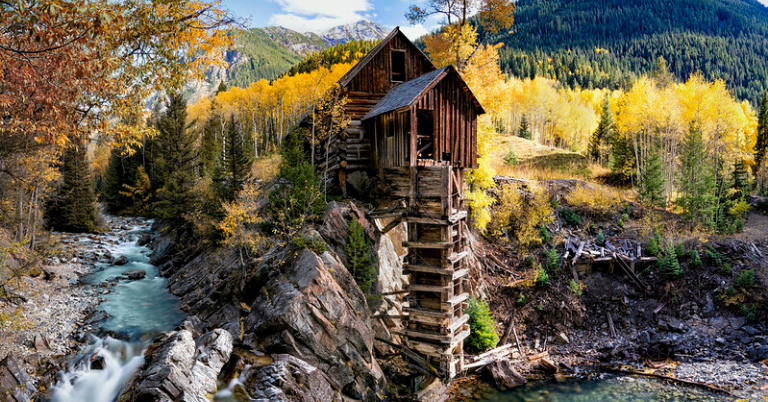
Crystal Mill looks more like something you might see at Disneyland rather than in the middle of the Rocky Mountains, but this former mill is on the National Register of Historic Places. Just a 90-minute drive from Aspen, you’ll find Crystal Mill outside the small town of Marble, Colorado.
When it comes to visiting Crystal Mill, choose your own adventure. You can travel by foot, bike, jeep, or even horseback to take a tour. There’s nothing wrong with “doing it for the ‘gram,” and if you need to access a different location for the perfect picture, the owner of the land can make it happen with a purchasable pass.
18. Mount Toll
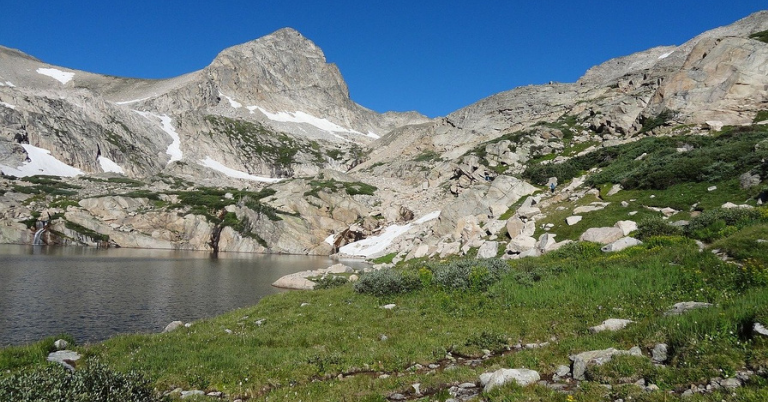
The Indian Peaks Wilderness (IPW) is often the forgotten child of Rocky Mountain National Park, but the scenery, mountains, and adventure are dang-near identical between these two majestic areas. To access Mount Toll, head on over the Brainard Lake Recreation Area. You won’t find much solitude at the trailhead or along the beginner-friendly trails down low, but you’ll start to find the seclusion you’re looking for higher up on the ~13,000-foot peaks.
The easiest way up Mount Toll is by parking at the Long Lake Trailhead. Make your way up to the Pawnee Pass Trail and take it all the way to the alpine pass. From here, you’ll head north over Pawnee Peak and down and over to Mount Toll. Once you’ve passed Pawnee Peak, there’s a good chance you won’t see another soul on your way up to the next summit.
Another route is from the Mitchell Lake Trailhead. From here, you can hike up to the Blue Lakes and begin your adventure from here. There are Class 2 and Class 3 options on these paths, so be careful and study your routes in advance. Regardless of your choice, this is a fun peak you won’t forget.
19. Spectacle Lakes
Rocky Mountain National Park is one of the nation’s most popular national parks, but that doesn’t mean you can’t find quiet and solace (if you look hard enough). The northern side of the park doesn’t get quite the same love and attention as the Bear Lake area, and that makes for lucky hikers who like to get off the beaten path.
Spectacle Lakes lie under Ypsilon Mountain, one of the park’s brilliant 13,000-foot mountains. These lakes are beautiful, alpine lakes with stunning panoramic views of the park. And there’s a good chance you’ll have them all to yourself, depending on the day.
20. Fulford Cave
Fulford Cave is considered a beginner’s cave, as it doesn’t require any technical climbing. However, you’ll still want good shoes, appropriate clothing, helmets, and lamps before adventuring into these tunnels. Oh, and a permit, too.
Not many people know about Fulford Cave, and it’s not necessarily easy to reach, which makes it one of Colorado’s best-hidden gems. Spelunkers will find countless stalagmites and multiple levels to explore in this cavern. It’s Colorado’s 8th largest cave, and it promises to be a grand adventure whenever you take the time to venture to it.
21. Spanish Peaks
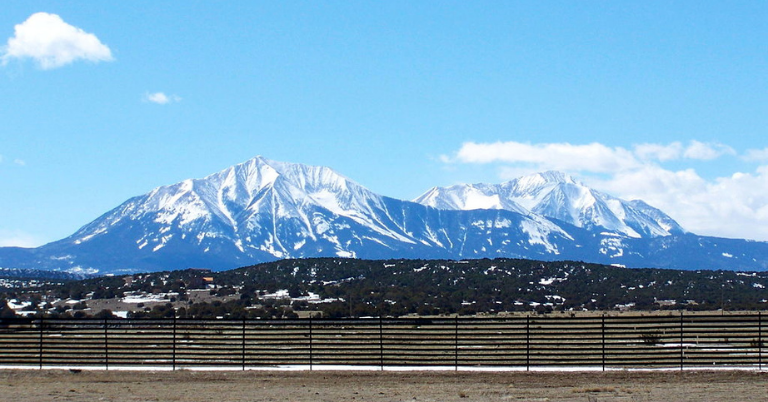
You’ll find the remote Spanish Peaks in southern Colorado, close to the border of New Mexico. West Spanish Peak rises to 13,626 feet, while East Spanish Peak is 12,683 feet. These tall mountains not only make for an excellent peak-bagging journey, but they’re also a National Natural Landmark due to the Spanish Peaks being one of the world’s best examples of igneous dikes.
Hiking isn’t your only way to experience this mountain wilderness. Take a road trip along the Highway of Legends (a route connecting Walsenburg with Trinidad via La Veta) to get jaw-dropping views of these beautiful peaks.
Discover More of Colorado
Whether you ski, hike, bike, climb, or simply like to roam, Unknown Colorado has the cure to satisfy your wanderlust. Browse through our different categories to find the adventure that speaks to your tastebuds.
Colorado has countless hidden gems waiting for you to find them. Get out there and explore.

